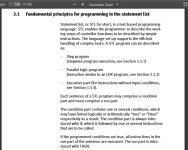Hi dear enthusiasts ,
,
I am taking a PLC course where we use Festo PLC (FC660). I did some LDR programming before and not until recently I thought that was the best way to program the PLC. I was recently introduced to STL which is a lot like assembly language and since then my confusion has been increasing . What is the difference between LDR and STL, besides just the appearance? My teacher asked me to only put the tasks which can happen any time (or must be accounted for at any given time) in the LDR. He asked me to put the rest of the process stages in a sequential format in the STL. He told me the STL format takes care of the sequential stages not things which may happen at any stage (i.e. pressing a stop button any given time).
. What is the difference between LDR and STL, besides just the appearance? My teacher asked me to only put the tasks which can happen any time (or must be accounted for at any given time) in the LDR. He asked me to put the rest of the process stages in a sequential format in the STL. He told me the STL format takes care of the sequential stages not things which may happen at any stage (i.e. pressing a stop button any given time).
So, I am a bit confused now. What purpose do STL and LDR serve? Can I not just use one or do I have to use both in a program. I used to only use LDR as my course of study was only limited to it. Also I was told that LDR is also sequential and now I am told otherwise, I am told that it can take care of things that happen any time in the process. Now, I came across the term “quasi-parallel” or “pseudo-parallel” logic. How does that fit in LDR and STL working together and where does it come into play?
Any help and resources are appreciated
I am taking a PLC course where we use Festo PLC (FC660). I did some LDR programming before and not until recently I thought that was the best way to program the PLC. I was recently introduced to STL which is a lot like assembly language and since then my confusion has been increasing
So, I am a bit confused now. What purpose do STL and LDR serve? Can I not just use one or do I have to use both in a program. I used to only use LDR as my course of study was only limited to it. Also I was told that LDR is also sequential and now I am told otherwise, I am told that it can take care of things that happen any time in the process. Now, I came across the term “quasi-parallel” or “pseudo-parallel” logic. How does that fit in LDR and STL working together and where does it come into play?
Any help and resources are appreciated





